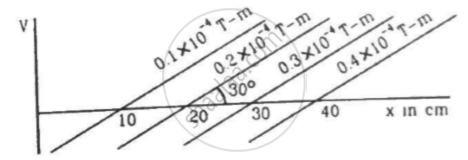Advertisements
Advertisements
प्रश्न
To measure the magnetic moment of a bar magnet, one may use
(a) a tangent galvanometer
(b) a deflection galvanometer if the earth's horizontal field is known
(c) an oscillation magnetometer if the earth's horizontal field is known
(d) both deflection and oscillation magnetometer if the earth's horizontal field is not known
उत्तर
(b) a deflection galvanometer if the earth's horizontal field is known
(c) an oscillation magnetometer if the earth's horizontal field is known
(d) both deflection and oscillation magnetometers if the earth's horizontal field is not known
Denial of (a):
Tangent galvanometer is an instrument used to measure electric current; it cannot be used to the measure magnetic moment of a bar magnet.
Justification of (b) and (c) :
Deflection magnetometer is used to measure `M/B_H` of a permanent bar magnet.
Similarly, oscillation magnetometer is used to measure `MB_H` of a bar magnet. So, if earth's horizontal field, `B_H` is known, then the magnetic moment of a bar magnet, M, can be measured.
Justification of (d):
Using deflection and oscillation magnetometers, we can calculate `M/B_H` and `MB_H` respectively . Therefore, if we multiply the result obtained from both the instruments, then BH cancels out as `M/B_H xx MB_H = M^2` . Thus, the value of `B_H` is not required.
Therefore, we can use both deflection and oscillation magnetometers if the earth's horizontal field is not known.
APPEARS IN
संबंधित प्रश्न
State any two advantages of electromagnets over permanent magnets.
Write two characteristics of a material used for making permanent magnets ?
Why is the core of an electromagnet made of ferromagnetic materials?
Compare the direction of the magnetic field inside a solenoid with that of the field there if the solenoid is replaced by its equivalent combination of north pole and south pole.
Two long bare magnets are placed with their axes coinciding in such a way that the north pole of the first magnet is 2.0 cm from the south pole of the second. If both the magnets have a pole strength of 10 Am, find the force exerted by one magnet of the other.
A uniform magnetic field of `0.20 xx 10^-3 "T"` exists in the space. Find the change in the magnetic scalar potential as one moves through 50 cm along the field.
Figure shows some of the equipotential surfaces of the magnetic scalar potential. Find the magnetic field B at a point in the region.

Show that the magnetic field at a point due to a magnetic dipole is perpendicular to the magnetic axis if the line joining the point with the centre of the dipole makes an angle of `tan^-1(sqrt 2)` with the magnetic axis
A bar magnet has a length of 8 cm. The magnetic field at a point at a distance 3 cm from the centre in the broadside-on position is found to be `4 xx 10^-6 "T"`.Find the pole strength of the magnet.
Why is it not possible to make permanent magnets from paramagnetic materials?
The magnetic moment of the assumed dipole at the earth's centre is 8.0 × 1022 A m2. Calculate the magnetic field B at the geomagnetic poles of the earth. Radius of the earth is 6400 km.
A short magnet produces a deflection of 37° in a deflection magnetometer in Tan-A position when placed at a separation of 10 cm from the needle. Find the ratio of the magnetic moment of the magnet to the earth's horizontal magnetic field.
The magnetometer of the previous problem is used with the same magnet in Tan-B position. Where should the magnet be placed to produce a 37° deflection of the needle?
The combination of two bar magnets makes 10 oscillations per second in an oscillation magnetometer when like poles are tied together and 2 oscillations per second when unlike poles are tied together. Find the ratio of the magnetic moments of the magnets. Neglect any induced magnetism.
A short magnet makes 40 oscillations per minute when used in an oscillation magnetometer at a place where the earth's horizontal magnetic field is 25 μT. Another short magnet of magnetic moment 1.6 A m2 is placed 20 cm east of the oscillating magnet. Find the new frequency of oscillation if the magnet has its north pole (a) towards north and (b) towards south.
Choose the correct option:
Soft iron is used to make the core of the transformer because of its ______.
A steel wire of length 1 has a magnetic moment m it is then bent into a semicircular arc. The new magnetic moment is
Which of the following is most suitable for the core of an electromagnet?
Which magnetic properties are desirable for making a permanent magnet?
